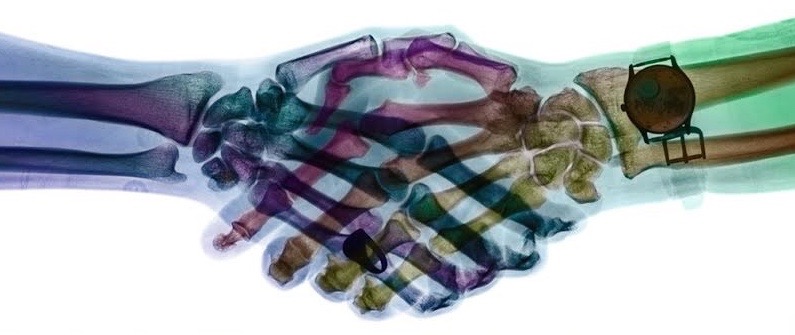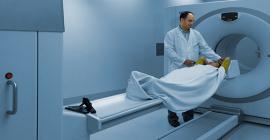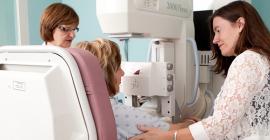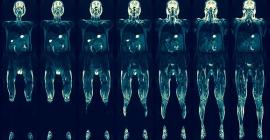
Peer Review
Peer Review in the Delivery of Radiology Services
The Canadian Association of Radiologists’ (CAR) 2011 Guide to Peer Review Systems defines peer review as a process for the self-regulation by a profession or a process of evaluation involving qualified individuals within the relevant field. Peer review methods are employed to maintain standards, improve performance and provide credibility.
The assessment of diagnostic interpretation accuracy, through peer review is the most commonly employed method for assessing ongoing performance in terms of medical and clinical knowledge in radiology and is a key process in physician performance evaluation geared primarily towards measuring diagnostic accuracy.
The American College of Radiology (ACR) is seen as the international leader in implementing peer review under a system called RADPEER that incorporates the well established principles as essential elements.
“Our focus is to put forward recommendations that are informed by best practices and that lead to consistent standards across the province. Ultimately our goal is to improve the quality of radiology services, contribute to radiologists’ learning, and enable the identification of possible quality problems to informed decisions about patient treatment, physician training, and continuing medical education.”
Joshua Tepper, MD President & CEO – Health Quality Ontario
Elements of Peer Review
- Is non-punitive with an ongoing learning focus to promote a culture of patient safety
- Includes a double reading (2 radiologists interpreting the same study) on a randomised selection of a sub-set of studies to be reviewed on a regularly scheduled basis
- Is shielded from legal disclosure via legislation like Ontario’s Quality of Care Information Protection Act (QCIPA) for quality improvement purposes except where an incorrect finding is discovered that would affect a patient’s health and/or quality of life
- Ensures that exams and procedures are representative of the actual clinical practice of each imaging physician in a fair and transparent evaluation of performance by a physician’s peers to identify opportunities for additional education, error reduction, and self-improvement
- Includes reviewer assessment of agreement of the original report with subsequent review (or with surgical or pathological findings)
- Incorporates a classification of peer review findings with regard to level of quality concerns using a 4-point scoring scale as developed by the ACR
- Has in place policies and procedures for action to be taken on significant discrepant peer review findings for the purpose of achieving quality outcome improvements
- Provides summary statistics and comparisons generated for each physician by imaging modality
- Produces summary data for each facility/practice by modality
Peer Review in Ontario
In December 2013, the Minister of Health struck a committee led by Health Quality Ontario composed of key stakeholder groups including the Ontario Association of Radiologists, the Ontario Medical Association, the College of Physicians and Surgeons of Ontario, Cancer Care Ontario, the Ontario Hospital Associations and other experts.
The DI Expert Panel was tasked with:
- Developing recommendations to government for the implementation of a practical, province-wide physician peer review for diagnostic imaging
- Facilitating collaboration with the aim of achieving consensus on the core components of a peer review program and developing recommendations for a phased implementation
- Providing advice on a broader quality assurance program in DI, which may involve additional approaches to ensuring continuous quality improvement such as accreditation
Ontario’s Peer Review Expert Panel were guided by the use of principles that would be applied to Diagnostic Imaging services initially and later be applied similarly to other branches of medicine involved in diagnostic imaging service delivery to patients.
Peer Review Principles for Consideration in Ontario’s Health Care System
- Integrated within a broader quality framework
- Standards-based
- Provincial consistency and coverage
- Learning and education focused
- Accountable
- Sustainable
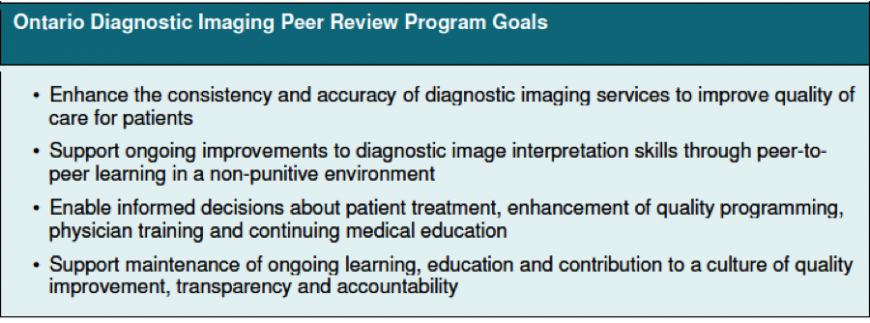
The Expert Panel on Diagnostic Imaging Quality issued a report under the auspices of Health Quality Ontario in December 2014. See Diagnostic Imaging Quality Report link.
http://www.hqontario.ca/Portals/0/documents/about/di-expert-panel-report-en.pdf



